Chapter: civil : Applied Hydraulic Engineering: Gradually Varied Flow
Surface Profiles Determination
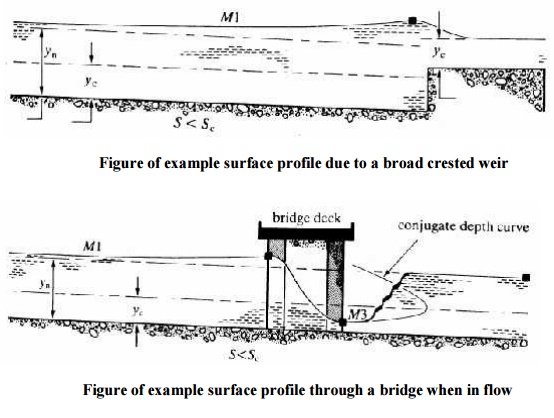
Civil -
Applied Hydraulic Engineering: Gradually Varied Flow
Surface Profiles Determination
Before one of the profiles
discussed above can be decided upon two things must be determined for the
channel and flow:
a)
Whether the slope is mild, critical or steep. The
normal and critical depths must be calculated for the design discharge
b) The
positions of any control points must be established. Control points are
points
of known
depth or relationship between depth and discharge. Example are weirs, flumes,
gates or points where it is known critical flow occurs like at free outfalls,
or that the flow is normal depth at some far distance down stream.
Once these control points and depth position has
been established the surface profiles can be drawn to join the control points
with the insertion of hydraulic jumps where it is necessary to join sub and
super critical flows that don't meet at a critical
depth.
Below are
two examples.

This
shows the control point just upstream of a broad crested weir in a channel of
mild slope. The resulting curve is an M1.
This shows how a bridge may act
as a control - particularly under flood conditions.
Upstream there is an M1 curve then flow through the bridge is rapidly varied
and the depth drops below critical depth so on exit is super critical so a
short M3 curve occurs before a hydraulic jump takes the depth back to a
sub-critical level. Method of solution of the gradually varied flow equation.
There are
three forms of the gradually varied flow equation:

In the past direct and graphical
solution methods have been used to solve these, however these method have been
superseded by numerical methods which are now be the only method used.
Profile Determination by Numerical method
All (15) of the gradually varied flow profiles
shown above may be quickly solved by simple numerical techniques. One computer
program can be written to solve most situations.
There are
two basic numerical methods that can be used
i. Direct
step - distance
from depth
ii. Standard
step method - depth from distance
1.The
direct step method - distance
from depth
This method will calculate (by integrating the
gradually varied flow equation) a distance for a given change in surface
height.
The
equation used is 1.28, which written in finite difference form is

The steps in solution are:
1. Determine
the control depth as the starting point
2. Decide on
the expected curve and depth change if possible
3. Choose a
suitable depth step ?y
4. Calculate
the term in brackets at the 'mean' depth (y
initial + ?y/2)
5. Calculate
? x
6. Repeat 4
and 5 until the appropriate distance / depth changed reached
2.The standard step method
- depth
from distance
This method will calculate (by integrating the
gradually varied flow equation) a depth at a given distance up or downstream.
The
equation used is 1.27, which written in finite difference form is

The steps
in solution are similar to the direct step method shown above but for each x
there is the following iterative step:
1. Assume a
value of depth y (the control depth or the last solution depth)
2. Calculate
the specific energy EsG
3.
Calculate S f
4.
Calculate ? Es using
equation 1.30
5.
Calculate E
s(x+ ?x )
s = E + ? E
6.
Repeat until
?E s (x+ ?x) = E sG
The Standard step method -
alternative form
This method will again calculate
a depth at a given distance up or downstream but this time the equation used is
1.26, which written in finite difference form is

The strategy is the same as the first standard step method,
with the same necessity to iterate for each step.
2.Graphical Integration Method
This is a simple and straight
forward method and is applicable to both prismatic and non prismatic channels
of any shape and slope.
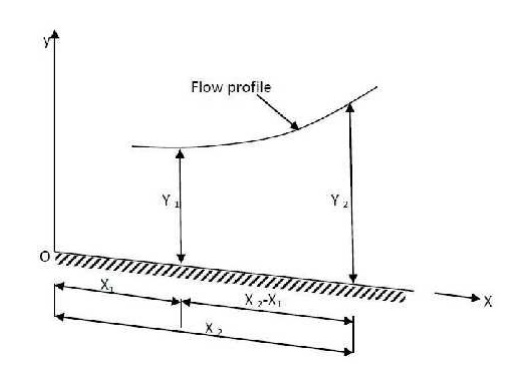
Consider two channel sections at
distances x1 and x2 from a chosen reference O as shown in figure above. The
depths of flow are y1 and y2 respectively; Let, L= x2-x1, we have
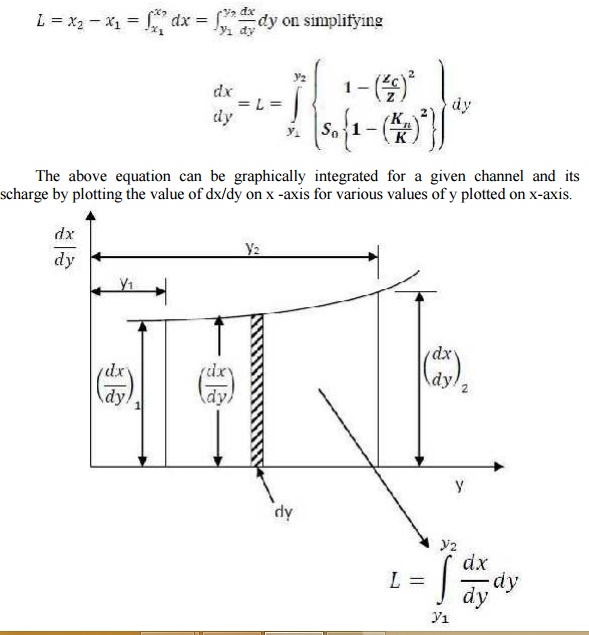
The above equation can be graphically integrated
for a given channel and its discharge by plotting the value of dx/dy on x -axis
for various values of y plotted on x-axis.
By measuring the area formed by the curve, (the
x-axis and the ordinates of dx/dy at y=y1 and y=y2 ) L can be determined. The
area can also be determined by computing theordinates dx/dy for different
values of y and then, calculating the area between the adjacent ordinates.
Summing these areas, one can obtain the desired length L.
Problem: A river
100 m wide and 3m deep has an average bed slope of 0.0005. Estimate the
length of the GVF profile produced by a low weir which raises the water surface
just upstream of it by 1.5 m. Assume N = 0.035. Use direct step method with
three steps. To estimate the length of the GVF profile
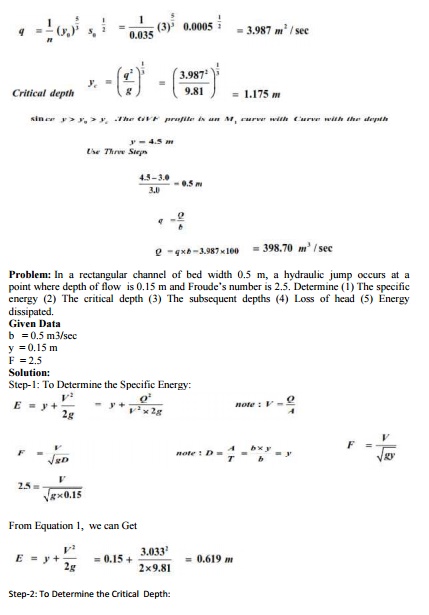
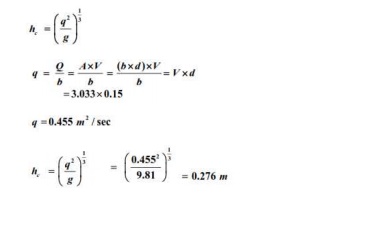
Related Topics